Grumpy
Well-known member
My beam, with the small shield removed, looks very much like yours.OK, I just finished the install. I stacked the 2 super slim ballasts and stuck them together with doubles-sided stick foam tape, then stuck the pair on top of the left side headlight. I ran the HV wires down between the headlights which put the 2 ignitors captive between the headlights. I tie wrapped the bottom of the HV wires to the frame that runs across between the two headlights and then ran the wires up to the capsules. It worked out pretty neatly. I put the relay box and bundled up excess wire in front of the glove box. There's a pretty good sized cavity on 1st gens right there.I found that the extra wiring length was more than I was willing to try and find a place for, so I spent a fair amount of time triming and splicing wires.
I removed the small shield that traveled with the arc tube as it moved as it wasn't needed.
Jim
So in summary, it was a fairly easy install on a 1st gen. I would expect that a 2nd gen should be just as easy as long as you can find a spot for the relay box and excess wires.
I may remove that shield eventually too, as I think it does interfere with the high beam pattern some, but it looks like it is there to seal off the big hole in the stationary shield when in low beam. Did you notice the low beams leaking any light above the cut-off after you removed the shield? Also, when you removed it did it look like you could put it back if you had to?
jim

































































